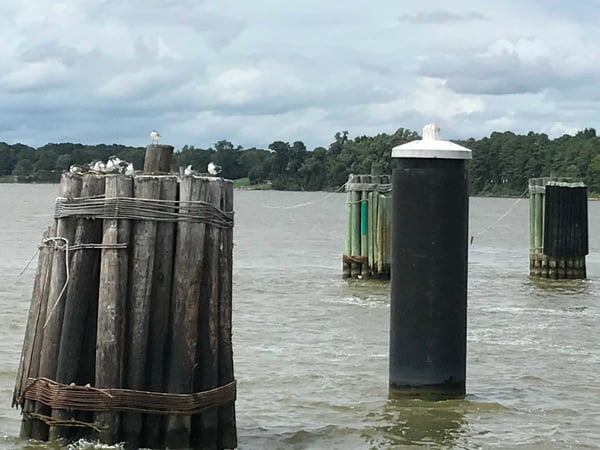
In 1758, Great Britain’s Royal Navy used copper sheathing to clad the bottoms of its warships. But it wasn’t to shield the wooden hulls from artillery or the ravages of seawater. The alloy “armor” was designed to ward off the insidious onslaught of the Teredo navalis—commonly called Shipworm. This species of mollusk, which proliferated in temperate and tropical waters, posed a greater threat to fleets on lengthy voyages from colder waters. Today the Teredo is found in oceans worldwide and remains notorious for its specialty: boring into and eating away a wooden ship’s hull.
Shipworms are also the bane of wooden docks, pilings and dolphins. Often paired with structural seawalls or docks, dolphins protect these structures from vessel impact and also help secure vessels like barges during loading and unloading. Pile quantity per wooden dolphin can range from as little as three to more than 50 timber piles. Dolphins can also be built as a steel platform that encloses a mixture of reinforced concrete and piles.
To find out if your pilings have become a condominium for the malicious mollusk, one has to don scuba gear and perform a physical inspection. The tiny worms leave 1/16-inch round holes in wood pilings and dolphins near or below the water's surface. And you can’t get rid of them with pesticides. Marine contractors tend to refer to Teredo or shipworms as termites because their activity mimics that of the insect most home dwellers fear. Once shipworms locate pilings or dolphins, they burrow through the wood until there is nothing left.
A 21st century answer to the copper sheathing employed in the 1700s is fiber reinforced polymer (FRP). FiberPILE gives you a single, large diameter product that can be designed to offer strength and stiffness comparable to that of an entire cluster of timber piles. Able to provide the strength of steel, the product has a much lower bending stiffness which allows for greater energy absorption than traditional materials. Unlike wood timbers, the FRP piles will not rot and are impervious to marine borers. In addition to the maintenance savings, the initial installed cost of large diameter FRP piles is competitive with timber dolphins because of the reduced labor and equipment costs required to drive a single FRP pile instead of 50 wood piles.
Want to avoid ever getting wet looking for shipworms? Contact us today to find out more about FRP and FiberPILE.
